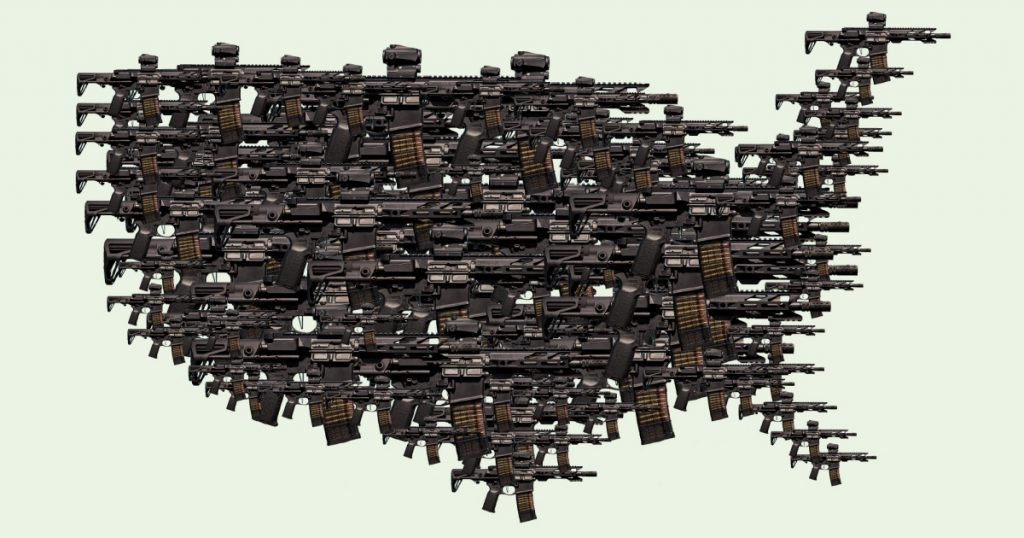How a Weapon of War Has Worsened the Mass Shootings Epidemic
Mother Jones; Unsplash
Fight disinformation: Sign up for the free Mother Jones Daily newsletter and follow the news that matters.It was a grim but not terribly surprising coincidence. Last Monday morning, just a few hours after the Washington Post published a new series on the popular semiautomatic rifles known as AR-15s, a suicidal 28-year-old used one to murder three children and three adults at a Nashville elementary school. It was the sixth mass shooting in the past 10 months committed with this type of highly lethal firearm, according to our Mother Jones database.
Semiautomatic pistols used to be the top weapon of choice for mass shooters. But ever since the massacres at a Colorado movie theater and a Connecticut elementary school just over a decade ago, many perpetrators of these crimes have armed themselves with AR-15s and caused growing carnage. The phenomenon accelerated further with five high-profile attacks in 2022, beginning with those in Buffalo and Uvalde. (In the several years prior: the massacres in Las Vegas, Sutherland Springs, Parkland, Pittsburgh, Gilroy, El Paso, Dayton, Boulder, Indianapolis—the list quickly grows long.) Mass shooters increasingly also use body armor, tactical vests, and other tactical gear, the Nashville perpetrator included. As I reported in December:
The past decade brought a sharp increase in shooters using military-style semiautomatic rifles. Among the 83 mass shootings since 2012 documented in the Mother Jones database (whose perpetrators also include several high school adolescents and various middle-age men), 34 of the cases involved such assault rifles.
As those weapons have soared in popularity in the United States, there also remains scant regulation of the military-grade body armor that mass shooters increasingly use. Such gear helped protect the perpetrator who committed the racist mass murder at the supermarket in Buffalo; his body armor stopped a bullet fired by a security guard, whom he then fatally shot. Body armor also made it more difficult to stop the attacker at Club Q in Colorado Springs, according to the military veteran who heroically took him down.
This disturbing trend connects in part to how mass shooters emulate previous attackers as they plan and prepare, one of multiple common warning behaviors I examine in Trigger Points, my book about preventing mass shootings through the method of threat assessment. The weapons and gear these perpetrators select has coincided with aggressive marketing tactics long used by the gun industry:
Threat assessment research shows that many mass shooters fixate on military-style weapons and gear and identify with a “commando” mentality. The problem has grown against a backdrop of gun manufacturers aggressively marketing semiautomatic rifles as emblematic of military and masculine prowess, including through product placement in movies and video games popular with young males. The type of “Bushmaster” rifle wielded by the Sandy Hook shooter had been billed as a means for buyers to get their “man card” in advertising from its maker, Remington, which agreed early this year to a landmark $73 million civil settlement with victims’ families. The family of a 10-year-old victim in Uvalde filed suit in November against Daniel Defense, the maker of the rifle used at Robb Elementary, alleging the company used militaristic marketing appeals to target “young male consumers.”
The new reporting from the Post adds some striking detail about how the firearms industry collaborated with video game companies to captivate young potential buyers. In 2010, representatives of two gun manufacturers met at a Nevada shooting range with technicians working on the blockbuster first-person shooter, “Call of Duty,” to record the firing of AR-15s and other weapons. “No detail, even the click of inserting a magazine, was too small to capture, participants said,” according to the Post.
The fast rising popularity of AR-15s—a civilian version of a rifle that was designed for maximum killing in war—drove booming overall gun sales. A Mother Jones investigation seven years ago into the secretive world of America’s 10 biggest gun manufacturers estimated an $8 billion annual business. As we reported then, Remington Outdoor, the maker of the AR-15 used in the Sandy Hook massacre in 2012, saw its profits increase nearly thirtyfold over the following year—with the biggest jump in sales coming from assault rifles.
Today, the gun industry estimates that at least 20 million AR-15s are in circulation throughout the country, according to the Post. Nearly 14 million of those were manufactured by US gun companies over the past decade alone, generating sales revenues of roughly $11 billion.
The Post series also spotlights the horrific damage that these weapons can do to human bodies big and small, like those of the three nine-year-olds gunned down in Nashville. The velocity and impact of the .223-caliber rounds can blast apart organs and demolish bones, as the Post illustrates with videos that are harrowing to watch even just as animated visualizations. The bodies of some children killed at Robb Elementary school in Uvalde, where 19 students and two teachers perished, were so obliterated that authorities had to resort to DNA testing to identify those victims.
Moreover, AR-15s have stark implications for law enforcement responding to mass shootings, as the Texas Tribune revealed recently with an important investigation into the catastrophe in Uvalde. A significant reason why police failed for an excruciatingly long time to confront the shooter, who was hunkered down inside a classroom with dying victims, was because they feared the firepower of his AR-15 and felt outgunned. According to the Tribune, multiple officers who spoke with investigators in the aftermath of the botched response said that they were unwilling to confront the rifle on the other side of the classroom door.
“You knew that it was definitely an AR,” said one Uvalde PD officer. “There was no way of going in…We had no choice but to wait and try to get something that had better coverage where we could actually stand up to him.”
Even by the standards of America’s woefully entrenched political battle over gun regulations, the response to these recurring massacres from various Republican lawmakers remains astounding. Texas Republicans apparently sought to bury the police fears about the shooter’s weapon in Uvalde, according to the Tribune: “A comprehensive and scathing report of law enforcement’s response to the shooting, released by a Texas House committee chaired by Republican Rep. Dustin Burrows in July, made no mention of the comments by law enforcement officers that illustrated trepidation about the AR-15.”
A month after Uvalde, state Sen. Bob Hall argued that the perpetrator’s firepower was irrelevant because “he had enough time” to kill the 19 children and two teachers “with his hands or a baseball bat, and so it’s not the gun.”
At the national level, Republican lawmakers have been unanimous since the Nashville tragedy that they have no intention of strengthening regulations for AR-15s or other guns. A particularly shameful expression of their position came from Rep. Tim Burchett of Tennessee, whose district is home to the newly relocated headquarters of Smith & Wesson (which manufactured the semiautomatic pistol used by the Nashville shooter.)
“We’re not gonna fix it,” Burchett told reporters on Capitol Hill. “Criminals are gonna be criminals.” He suggested that the only solutions might be a “Christian revival” or homeschooling children, as his own family does. “I don’t see any real role that we could do other than mess things up,” he said.
He also recognized, awkwardly, the universality of the mass shootings scourge: “It doesn’t matter what state it’s happened in, we’re all Americans. It doesn’t matter the color of their skin, they all bleed red, and they’re bleeding a lot.”
Burchett’s comments were in their own right remarkably frank. He simply was reinforcing the commonly espoused theme that “nothing ever changes” with this problem, that there’s “nothing we can really do” about the epidemic of gun violence. It’s a national narrative that affirms outrage and despair, goes hand in hand with misguided blame on mental illness—and gives cover to politicians and others who profit from denying the fundamental role of ubiquitous, easily obtainable, highly lethal firearms.
The next mass shooting to occur somewhere in the country is almost certainly not a matter of if, but only when. And yet, the idea that we can essentially do nothing to stop it from happening stands as an insidious and damaging myth—one that America still, somehow, has yet to really confront.





